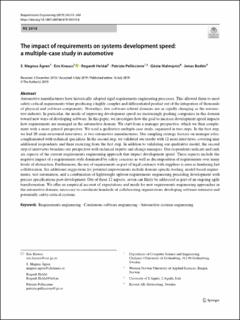| dc.contributor.author | Ågren, Magnus S. | |
| dc.contributor.author | Knauss, Eric | |
| dc.contributor.author | Heldal, Rogardt | |
| dc.contributor.author | Pelliccione, Patrizio | |
| dc.contributor.author | Malmqvist, Gösta | |
| dc.contributor.author | Bodén, Jonas | |
| dc.date.accessioned | 2020-08-28T08:57:33Z | |
| dc.date.available | 2020-08-28T08:57:33Z | |
| dc.date.created | 2020-02-19T10:03:10Z | |
| dc.date.issued | 2019 | |
| dc.identifier.citation | Ågren, S. M., Knauss, E., Heldal, R., Pelliccione, P., Malmqvist, G. & Bodén, J. (2019). The impact of requirements on systems development speed: a multiple-case study in automotive. Requirements Engineering, 24(3), 315-340. | en_US |
| dc.identifier.issn | 0947-3602 | |
| dc.identifier.uri | https://hdl.handle.net/11250/2675479 | |
| dc.description.abstract | Automotive manufacturers have historically adopted rigid requirements engineering processes. This allowed them to meet safety-critical requirements when producing a highly complex and differentiated product out of the integration of thousands of physical and software components. Nowadays, few software-related domains are as rapidly changing as the automotive industry. In particular, the needs of improving development speed are increasingly pushing companies in this domain toward new ways of developing software. In this paper, we investigate how the goal to increase development speed impacts how requirements are managed in the automotive domain. We start from a manager perspective, which we then complement with a more general perspective. We used a qualitative multiple-case study, organized in two steps. In the first step, we had 20 semi-structured interviews, at two automotive manufacturers. Our sampling strategy focuses on manager roles, complemented with technical specialists. In the second step, we validated our results with 12 more interviews, covering nine additional respondents and three recurring from the first step. In addition to validating our qualitative model, the second step of interviews broadens our perspective with technical experts and change managers. Our respondents indicate and rank six aspects of the current requirements engineering approach that impact development speed. These aspects include the negative impact of a requirements style dominated by safety concerns as well as decomposition of requirements over many levels of abstraction. Furthermore, the use of requirements as part of legal contracts with suppliers is seen as hindering fast collaboration. Six additional suggestions for potential improvements include domain-specific tooling, model-based requirements, test automation, and a combination of lightweight upfront requirements engineering preceding development with precise specifications post-development. Out of these 12 aspects, seven can likely be addressed as part of an ongoing agile transformation. We offer an empirical account of expectations and needs for new requirements engineering approaches in the automotive domain, necessary to coordinate hundreds of collaborating organizations developing software-intensive and potentially safety-critical systems. | en_US |
| dc.language.iso | eng | en_US |
| dc.publisher | Springer | en_US |
| dc.rights | Navngivelse 4.0 Internasjonal | * |
| dc.rights.uri | http://creativecommons.org/licenses/by/4.0/deed.no | * |
| dc.subject | requirements engineering | en_US |
| dc.subject | continuous software engineering | en_US |
| dc.subject | automotive systems engineering | en_US |
| dc.title | The impact of requirements on systems development speed: a multiple-case study in automotive | en_US |
| dc.type | Peer reviewed | en_US |
| dc.type | Journal article | en_US |
| dc.description.version | publishedVersion | en_US |
| dc.rights.holder | © The Author(s) 2019 | en_US |
| dc.subject.nsi | VDP::Matematikk og Naturvitenskap: 400::Informasjons- og kommunikasjonsvitenskap: 420::Systemutvikling og – arbeid: 426 | en_US |
| dc.source.pagenumber | 315-340 | en_US |
| dc.source.volume | 24 | en_US |
| dc.source.journal | Requirements Engineering | en_US |
| dc.source.issue | 3 | en_US |
| dc.identifier.cristin | 1795673 | |
| cristin.ispublished | true | |
| cristin.fulltext | original | |
| cristin.qualitycode | 2 | |

